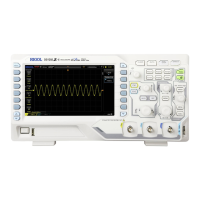
Do you have a question about the Rigol DS1202Z-E and is the answer not in the manual?
| Type | Tabletop |
|---|---|
| Product type | Digital sampling oscilloscope |
| Bandwidth | 200 MHz |
| Sampling rate | 500 MS/s |
| Frequency range | 0 - 0.001 MHz |
| Channels quantity | 2 channels |
| Vertical resolution | 8 bit |
| Minimum time base setting (per division) | 4 ns |
| Minimum vertical sensitivity (per division) | 1 mV |
| Display type | LCD |
| Display diagonal | 7 \ |
| Display resolution | 800 x 480 pixels |
| AC input voltage | 100 - 240 V |
| AC input frequency | 45 - 440 Hz |
| Power consumption (max) | 50 W |
| Operating temperature (T-T) | 0 - 50 °C |
| Package weight | 3500 g |
| Depth | 122.4 mm |
|---|---|
| Width | 313.1 mm |
| Height | 160.8 mm |
| Weight | 2900 g |
Outlines essential safety precautions to prevent personal injury and equipment damage during operation.
Explains safety notices and symbols used in the manual for hazard awareness.
Describes the layout and function of the oscilloscope's front panel controls and indicators.
Explains how to adjust the vertical scale (V/div) for waveform amplitude display, including coarse and fine adjustments.
Details memory depth settings and their relation to sample rate and horizontal time base for waveform storage.
Explains how to select trigger sources like analog channels, external trigger, or AC line for stable waveform capture.
Covers trigger modes (Auto, Normal, Single) that determine how the oscilloscope captures and stops data acquisition.
Introduces various trigger types including Edge, Pulse, Slope, Video, Pattern, Duration, and serial bus triggers.
Details automatic measurements of waveform parameters and statistics, including quick measurement features.
Provides solutions for issues related to the screen remaining dark after powering on the instrument.
Provides solutions for unstable waveform display, including checking trigger source, type, and level.
Offers troubleshooting steps for situations where no waveform is displayed after initiating waveform acquisition.